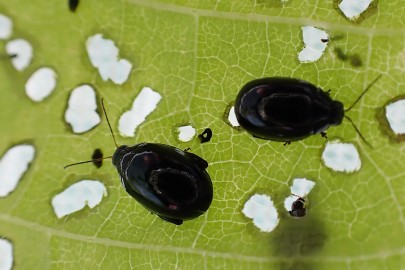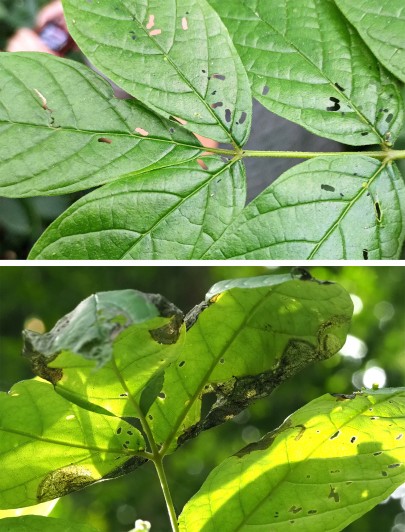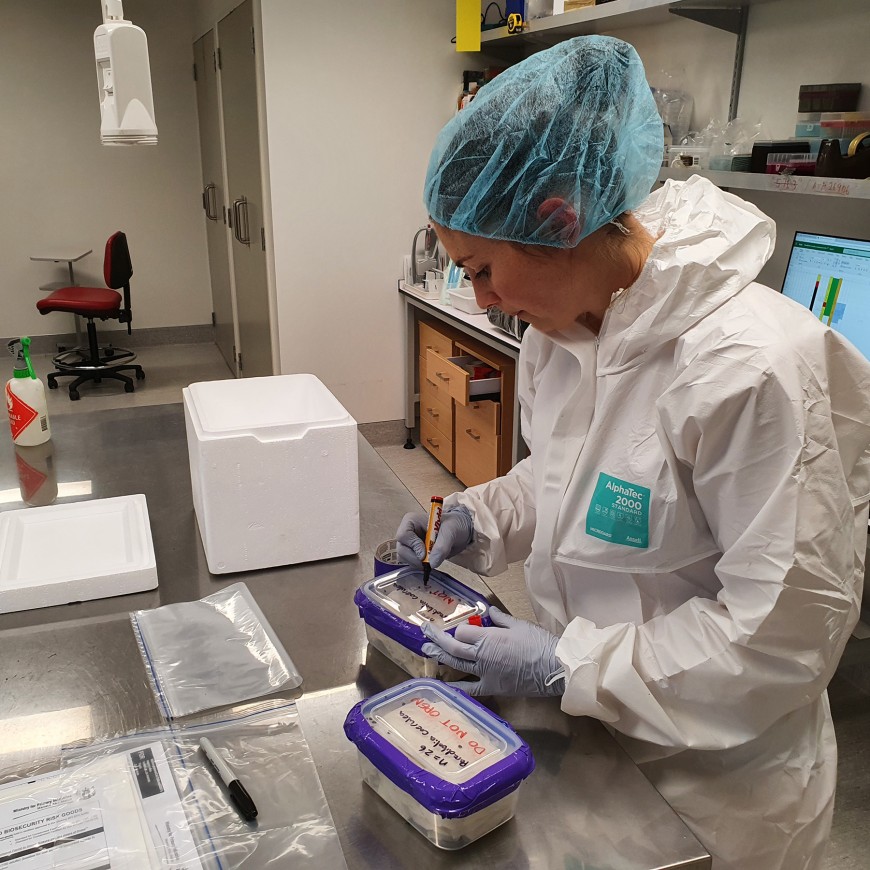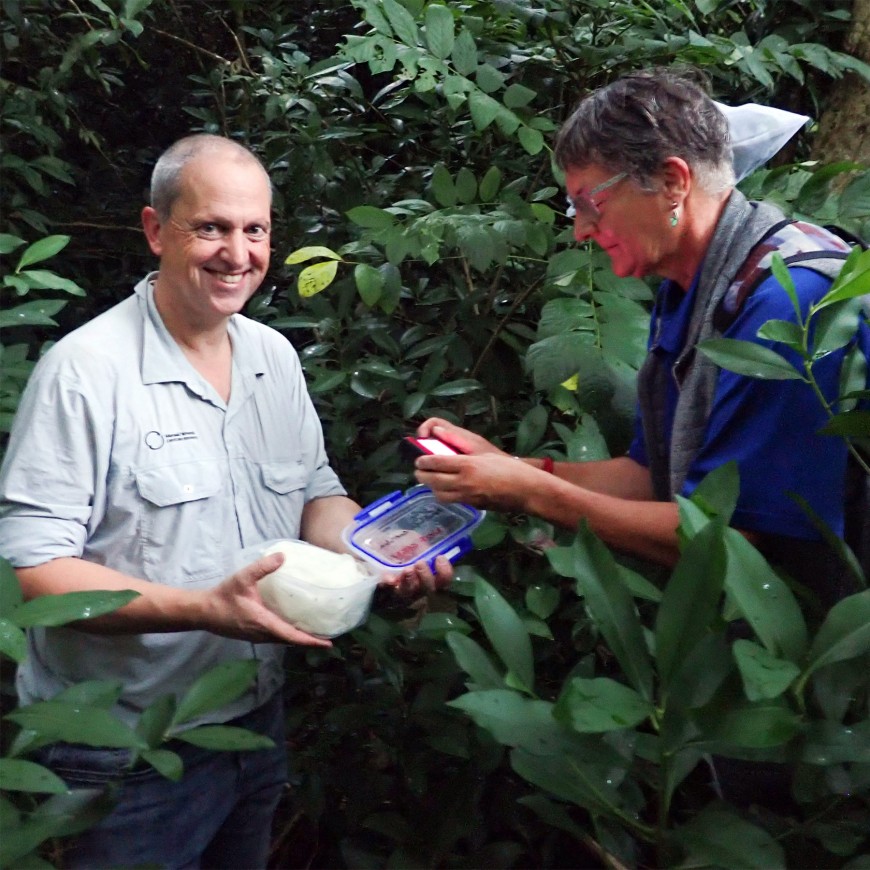A Travel Bubble Spells Freedom for a Long-Awaited Beetle for the Cook Islands

Flea beetle adults and damage
Manaaki Whenua researchers and collaborators at the Centre for Biological Control at Rhodes University in South Africa have been researching biocontrol options for African tulip tree for many years. The African tulip tree (Spathodea campanulata) is an evergreen tree native to tropical Africa, which has been widely distributed throughout the world as an ornamental for its showy, bright reddish-orange, tulip-shaped flowers. As a result of its prolific flowering and fruiting, the production of masses of wind-dispersed seeds and its suckering growth, this tree has become highly invasive in the pantropics, including several Pacific islands. It is considered one of the 100 worst alien invasive species in the world and one of the top 30 terrestrial invasive plants.
The African tulip tree flea beetle was prioritised as a candidate agent early on for its narrow host range. Adult flea beetles are defoliators, and the larvae mine the leaves of the African tulip tree, causing extensive damage through feeding. Once host specificity testing of the beetle in South Africa was complete and approval for its release in the Cook Islands was granted, it was impossible to find a reliable way to get the beetles from South Africa to New Zealand under worldwide Covid travel restrictions. A fortuitous turn of events finally came a year later when our new plant pathologist, Alana Den Breeyen, agreed to make space for the beetles in her suitcase on her journey over from South Africa.
However, another Covid snag, and Auckland’s snap lockdown in late February shortly after the beetle’s arrival led to an unexpected stay in Tamaki. This meant the ageing adult beetles would need to breed to ensure a healthy population for release once travel to the Cook Islands was permitted. “Fortunately, we already had African tulip tree plants growing in our containment facility, so we were able to keep a culture going,” said research leader, Quentin Paynter. “It took some careful rationing of the plants to rear enough beetles for a field release and to ensure they didn’t eat us out of house and home. We needed to maintain a laboratory culture in case the first release failed.”
The commencement of the New Zealand and Cook Islands travel bubble in mid-May finally put the wheels in motion and preparations were made to proceed with the release. Once the beetles arrived safely in Rarotonga, they were released by Quentin and research technician, Stephanie Morton. The release site for the beetles was carefully selected by Dr Maja Poeschko (Cook Islands Ministry of Agriculture) to ensure it would be free from routine insecticide spraying to manage mosquito populations to combat dengue fever.

Adult flea beetle damage 2 days (top) and a month (bottom) after release
“We initially released 40 beetles in four nylon rearing sleeves, to keep them contained and to ensure they didn’t rapidly disperse,” Quentin explained. “But we then decided to set 26 free, so that they could disperse, just in case we hadn’t chosen an ideal release site. When we returned to the site 2 days later, we easily found several adult beetles, indicating Maja had chosen a spot where the beetles were happy,” he added. Quentin also managed to make use of the travel bubble for some rest and relaxation a few weeks later in July and found extensive adult feeding damage as well as larval leaf mines. Maja confirmed she had seen adults just a few days before – encouraging early signs of establishment.
The flea beetle is the second agent to be released against the African tulip tree in the Cook Islands. A gall mite (Colomerus spathodeae), which forms leaf and stem galls that stunt new growth was released in 2017 and is now well established in Rarotonga. Although the damage by the mite doesn’t appear to be having a significant impact yet, it is hoped that the combined impact of the mite and the flea beetle will reduce the invasiveness of African tulip tree. Indeed, Stephanie noted that when rearing the mites and beetles in containment, a combination of the two agents together was highly damaging. Maja is regularly checking on the flea beetle so we will know by the end of this year if it has definitely established. The plan then is to monitor the combined impact of the two agents at least annually. Even if heavy damage is observed within 1-2 years, the impact of this on such a long-lived tree may take 5-10 years to become clear. There are also plans to release the mite in Tonga and Vanuatu before the end of year, and the beetles will continue to be mass-reared in New Zealand for additional releases in Rarotonga.
This biocontrol project is one of several for the Pacific region aimed at reducing the impacts of invasive species on the livelihoods of Pacific people. “Now more than ever, it is vital to get control of key alien plant invaders in this region,” said Lynley Hayes who is programme manager for MWLR’s Pacific projects. “Recent reports suggest that children in the Pacific are suffering more from poor nutrition as a result of Covid and climate change. Weeds contribute to this problem by making it more difficult to produce food,” she added. Other serious impacts of invasive alien plants include loss of biodiversity and a greater susceptibility to the threats associated with climate change. The release of African tulip flea beetle and the mite will hopefully take us one step closer to our goal of reducing the negative impacts of invasive species on the livelihoods of Pacific people.
Key contact



